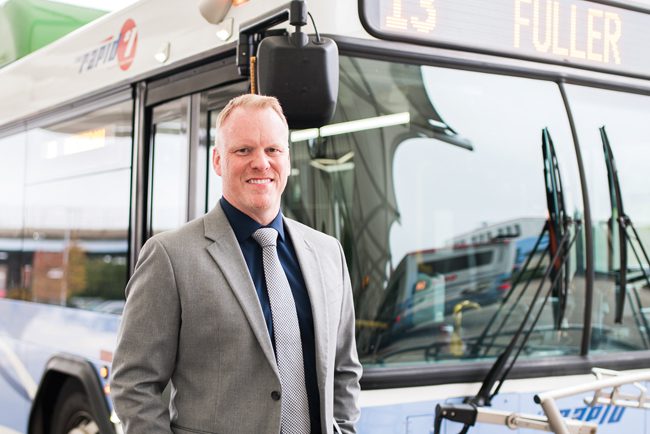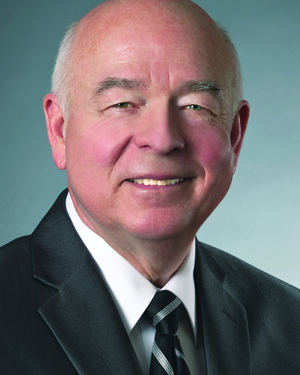

While any Michigan native can tell you our state is the birthplace of the automotive industry, far fewer know that public transit was alive and well in Detroit in the 1860s. Back then it was horse-drawn trolleys, which eventually gave way to electric streetcars in the 1890s. In both Southeast Michigan and West Michigan, public transit as we know it was born in the 1960s. Today, The Rapid in West Michigan and SMART in Metro Detroit are combining to help millions of riders get to work, school and other destinations.
For this issue focused on mobility, Corp! spoke with John C. Hertel, general manager of SMART (Suburban Mobility Authority for Regional Transportation), and Andrew Johnson, named CEO of Interurban Transit Partnership (The Rapid) in 2018.
Corp!: Looking back on 2018 what success story stands out?
John Hertel: SMART put into effect the express bus system, FAST [Frequent Affordable Safe Transit]. They are operating on Gratiot, Woodward and Michigan Avenue. From downtown, you can ride the FAST Michigan Avenue route to Detroit Metro Airport, which is the first major public transit system to actually serve the airport. Most significant is that our weekly ridership on those three routes is up 40 percent. Our weekend ridership is up 80 percent. We also have free Wi-Fi on all the FAST buses.
Andrew Johnson: I started in August, but prior to my tenure, The Rapid was able to get the capital investment grant released by the federal government to get the Laker Line funded. At the end of 2018, we received a $696,000 grant from the Federal Transit Administration as part of a new $945,000 effort to plan for development along the Silver Line Bus Rapid Transit route, focusing on the Division Avenue corridor from Wealthy to 60th streets. The Silver Line is Michigan’s first bus rapid transit route.

Corp!: What is on the horizon for 2019?
AJ: We will break ground on Laker Line. We are also looking to expand our compressed natural gas fleet. At our compressed natural gas fueling station, we are looking to expand and add a retail component so other users of compressed natural gas can fuel at the stop. We will be doing a transit-oriented study in the Silver Line corridor to look at how we can spark further development in the community, as part of the FTA grant. It’s a joint project between The Rapid, Grand Rapids, Wyoming and Kentwood. We are looking at this as a game changer.
JH: We have something called “Get A Job, Get A Ride!” If a business signs up for the program, when someone is given a new job, the person who gets the job is offered a one-month free pass to ride the SMART bus to work. We would like more people to use that. [Editor’s note: employees must meet eligibility requirements.]
We have the second smallest millage of any bus system in Michigan – 1 mill – and we have the largest square miles to cover. We have to apply most of our money to services. And our number one priority is to provide services to get people to work. We serve 850,000 jobs in the region and 70 percent of our riders every day are using SMART to get to work.
Corp!: When speaking to business leaders, how do you make the case for the value of public transit?
JH: I point out how successful public transit is in some of the major economic centers in the country. In every case, you can look at their public information and find that the more that was done to create a better system, the more jobs were created and larger profits were realized in those regions. From all the (industry) surveys, we know real estate values go up on properties near public transportation and young people graduating from college are not as interested in owning automobiles and are more interested in getting access to public transit.
AJ: The model that we currently have, and have had for many years, where we build large parking lots/ramps where everyone drives into work and drives home, is an antiquated model. We need to find new ways for employees to get to work. We want to give people choices, to get more and better qualified employees to worksites and to meet the needs of the new generation of employees who don’t want to own a car. We want to work with employers to find a way to offer good transportation to their employees and their business.
Corp!: How does your system support businesses, employment and economic development?
AJ: Last year, we unveiled Route 19, a partnership between The Rapid, Grand Rapids and Spectrum Health. Spectrum wanted to know how to get larger numbers of employees in and out of their facility. We created a route that serves remote parking lots, Spectrum and facilities along the Medical Mile. Route 19 is a completely different version of the route that existed before. It was serving about 54 people a day. Now it’s serving 1,100 people, primarily employees getting to and from work.
JH: Over last three years, we have worked cooperatively with Detroit Mayor Mike Duggan, who used to be head of SMART years ago, to coordinate the DDOT system with SMART and it’s working a lot more cohesively. One of the reasons it needs to is that 50 percent of people who live in Detroit and have jobs, work outside of Detroit and they need SMART to get to work. Two-thirds of people who work inside of the city limits come from the suburbs and they need SMART to get to work.
Corp!: As autonomous vehicles, rideshare services and mini-mobility are all developing, what do you think the future holds for public transportation?
JH: I actually think all those things bode well for public transit. The reason is those are all tentacles. The public transportation is the backbone. If you don’t have a strong backbone, the tentacles are not going to work. What you need is the strong corridors that move more people faster and more comfortably and at the same time, they become feeders for all these things.
AJ: Public transportation is in a great state of change. At The Rapid, we are shifting from public transportation to mobility coordination. Really, my vision for the organization is not to simply be buses and paratransit vans. We want to be a provider of mobility outcomes. With the state of disruption in the transportation area, there are new options popping up all the time and we have to integrate new choices for people.
Corp!: What is your guiding principle to live by?
AJ: My guiding principle really is to be fair, to treat people well and to serve. What I do benefits the community and people around me and that’s why I do what I do.
JH: I actually have two guiding principles. One is that (since age 22) I wanted to be involved in public service. The other is that family and friends are the most significant part of my personal life.
Corp!: What is the biggest management myth?
JH: I personally believe that you do not get the best results from people by constantly standing over them and checking on them and having all kinds of programs to check on them. You need to let professionals have some space and you need to demonstrate confidence in them by letting them have the freedom to utilize their talents and show you what they can do.
AJ: Delaying anything because everything is not perfect is not in the interest of the community. You have to be realistic with the resources you have available to get the best result.
Corp!: What is the most important lesson you have learned in business?
AJ: No matter how great the challenge seems, there is a way to resolve it. Getting too upset about things is not the best course of action. I didn’t always understand that early in my career.
JH: If you can create circumstances where people are going to rub shoulders with each other, you create a society where there is a lot better feeling and more cooperation. We have a society where people are more isolated and looking more at screens.
Corp!: What is your pet peeve in the office?
JH: Coming in to a stack of email.
AJ: Not being informed of things on a timely basis. I can handle bad news without too much trouble, but I don’t like surprises.
Corp!: Who is the most interesting person you’d like to meet and why?
AJ: Rosa Parks is very interesting to me, because of her impact on public transportation and how she shaped this business that I love so much.
JH: I would have liked to have met John F. Kennedy.






